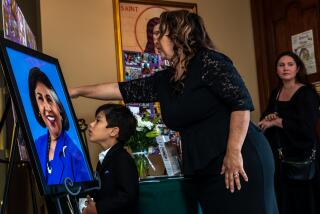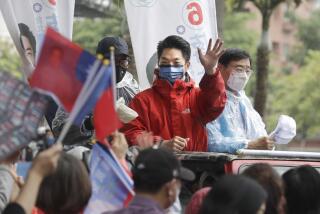‘The Last Empress’ by Hannah Pakula
- Share via
Madame Chiang Kai-shek may have acted like royalty, but she was not really China’s “Last Empress,” as the title of Hannah Pakula’s new book declares. Instead, Madame Chiang broke the mold for women in China, where she was the first and most influential first lady ever.
It’s a good story. A story of wartime travails, of high-stakes political gambling, of an epic fight-to-the-finish between authoritarian Nationalists and radical Communists. It’s also a story of a tempestuous partnership between an ascetic military man and his glamorous, winsome, shrewd and luxury-loving wife. He needed her connections to American money. She needed his access to power. Time magazine named them “Man and Woman of the Year” for 1937, essentially colluding in their myth-making. Together, they led China, and then lost it.
Madame Chiang dazzled Franklin Roosevelt, bedded Wendell Wilkie, backstabbed Gen. Joseph Stilwell and, for a time, enthralled the greater American public. Dynamic, vain, literary and ambitious -- she’s a great subject for a long biography.
“The Last Empress” is a beautifully designed book, with an inviting cover and an excellent array of photographs. Unfortunately, what lies between the covers is not as magical. Pakula, who previously wrote biographies of a Romanian queen (“The Last Romantic”) and a Prussian princess (“An Uncommon Woman”), often seems tone-deaf to the subtleties of Chinese culture and history. Here, her extended historical scene-setting can get distant from any connection to Madame Chiang. She does not match the insight and clarity of Laura Tyson Li’s 2006 biography of Madame Chiang, or the originality of Emily Hahn’s “The Soong Sisters” from 1941.
Then again, Madame Chiang’s story is so engrossing that, for those who like an old-fashioned approach, this long-form rendering is still pretty absorbing. Madame Chiang’s life spanned the entire 20th century, and she lived through a period of considerable upheaval, intersecting with quite a cast of characters.
Born in the last years of the 19th century, May-ling Soong was the youngest of three sisters whose father, Charlie, a Christian who made millions printing Bibles, bucked Chinese tradition by raising his daughters to be independent, savvy and ambitious. The eldest became one of China’s richest women. The second married Sun Yat-sen, China’s first president, and then cast her lot with Mao and the Communists. May-ling went to the U.S. for schooling at age 10, first in Georgia and then at Wellesley. When she returned to Shanghai, she said: “the only thing Oriental about me is my face.” Before long, however, she took to wearing elegant, body-hugging Chinese gowns on her slender figure. She drew many suitors, but none had quite the promise of young Chiang Kai-shek, a general who believed himself destined to lead China into a modern era. Chiang had to divorce one wife, pack off a second to graduate school in New York and promise to convert to Christianity before May-ling’s mother would approve the match.
“In seeking out a wife with money and power behind her, Chiang had found a woman with ideas and energy as well,” writes Pakula. May-ling had more than ideas and energy. She soon became a poised partner who could soften his imperiousness, write his speeches and eventually become his best diplomat and public relations agent. When Chiang joined Roosevelt and Churchill for a summit in Cairo, his wife simultaneously translated and refashioned his remarks.
Her finest hour came in 1943, when she went to the U.S. to appeal for support in the war against Japan. With a Georgia lilt in her fluent English, and impassioned speeches about an ancient culture transforming into a democracy, Madame Chiang charmed Washington and Congress. By the time she was done touring the country, she had secured political support for billions in aid. How much of it ended up in the pockets of the Chiangs and Soongs is an enduring mystery. Pakula made considerable efforts to find a paper trail, with limited success.
Madame Chiang suffered mysterious illnesses, and took lengthy stays in U.S. hospitals, with long separations from her husband. Their relationship was complex. There are signs of tenderness in surviving letters and telegrams, as well as eyewitness accounts of vicious arguments. Pakula airs some intriguing anecdotes. One has May-ling confiding to a friend that she and Chiang were never intimate, because he wanted no more children. Another suggests that he had been rendered infertile from venereal disease, and never told her. She did have a passionate affair with Wilkie, Roosevelt’s ex-rival for president. But she remained childless.
Eventually, Mao and the Communists defeated Chiang, chasing him to the island of Taiwan. The Chiangs vowed to retake China, but hope faded as the U.S. moved onto other wars in Korea and Vietnam. After Chiang died in 1975, Madame moved to New York, living until 2003. She was 105 years old. Or maybe 106. (She consistently hid her true age.)
Unfortunately, “The Last Empress” is riddled with silly errors that drive Chinaphiles crazy, like saying Beijing’s old Summer Palace covered “60,000 acres,” when it was really 875. Numerous names and dates are wrong. Pakula also has an annoying habit of abandoning judgment when she encounters conflicting evidence, resorting to phrases like “some say . . .” or “whatever the truth or falseness of these stories. . . .” From a historian who evidently spent 10 years with her material, we deserve more.
Madame Chiang trailblazed the role of first lady in China, and surpassed it. Her advocacy for the Nationalist cause was doomed, but she certainly cut a deep path on the consciousness of modern China.
Faison is the author of “South of the Clouds: Exploring the Hidden Realms of China.”
More to Read
The biggest entertainment stories
Get our big stories about Hollywood, film, television, music, arts, culture and more right in your inbox as soon as they publish.
You may occasionally receive promotional content from the Los Angeles Times.










